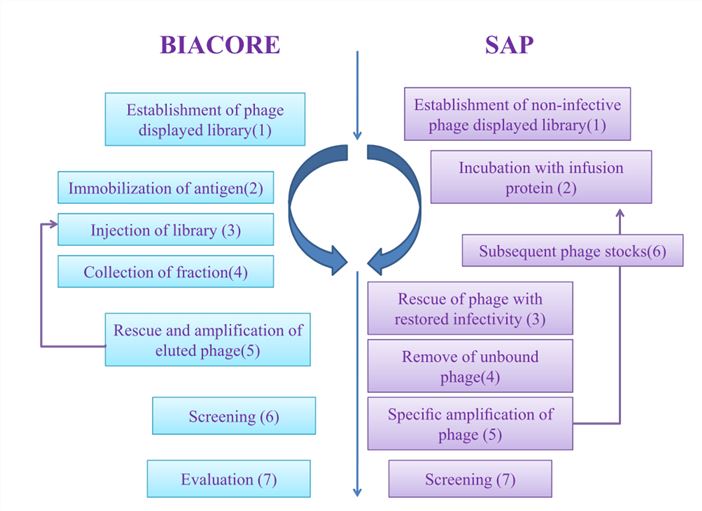Creative Biolabs provides high-quality service in phage display antibody library construction and screening. We have developed this selection strategy by using the Biacore technology and the specific amplification of phages approach to identify antibodies by their individual kinetic rate constants to meet the needs of different clients.
The display of antibody (Ab) fragments on the surface of filamentous bacteriophages and the selection methods have provided powerful tools to generate human antibodies. In phage display libraries, antibodies displayed on phages have been selected by binding to immobilized antigen, chromatography matrices, cells or biotinylated antigen. Molecular evolution approaches have become important tools for developing molecules with characteristics particularly suited for specific applications in biomedicine and biotechnology. Especially, when an Ab is used for tumor imaging or tumor therapy, the stable, non-dissociating interactions are favored. Although high affinity and specificity are often sought to ensure a high sensitivity of Abs selected in most conventional selection systems, which are based on the interaction between fragment phage-displayed and target antigen, a high throughput rather than a highly sensitive format is necessary under some conditions. In all the phage display systems, which tend to select for a slow dissociation rate of the complex, special attention must be paid to problems associated with avidity effects result from the multivalent display. It may be more important to have a rapid association rate and a rapid establishment of equilibrium than simply to have as panning based on high affinity alone. Furthermore, the kinetic parameters for Ag-Ab interactions, rather than the affinity alone, have been shown to associate with biological or technological performance. As well as, high-affinity antibodies could be difficult to elute, and clones with high dissociation might be lost. Creative Biolabs develops this strategy to isolate Abs from phage libraries by using the Biacore technology which is based on a reduced dissociation rate, and the specific amplification of phages (SAP) approach to identify Abs dependent on either their association rate constant or dissociation rate constant. By varying the time of antibody-antigen interaction or by using antigen-chase conditions, Fab fragments could be rapidly obtained. These technologies permit the selection of antibody fragments from large libraries with properties directly tailored for particular applications in biological and medical fields.
 Fig.1 Summary of procedures followed in Biacore-based and SAP-based procedures (Malmborg et al. 2002)
Fig.1 Summary of procedures followed in Biacore-based and SAP-based procedures (Malmborg et al. 2002)
Featured Advantages
Creative Biolabs’ scientists have extensive experience in phage display library screening based on Ab kinetic binding properties. By using the Biacore technology and SAP, Fab fragments can be selected based on their individual kinetic (association or dissociation) rate constants.
For more detailed information, please feel free to contact us or directly sent us an inquiry.
References
All listed services and products are For Research Use Only. Do Not use in any diagnostic or therapeutic applications.